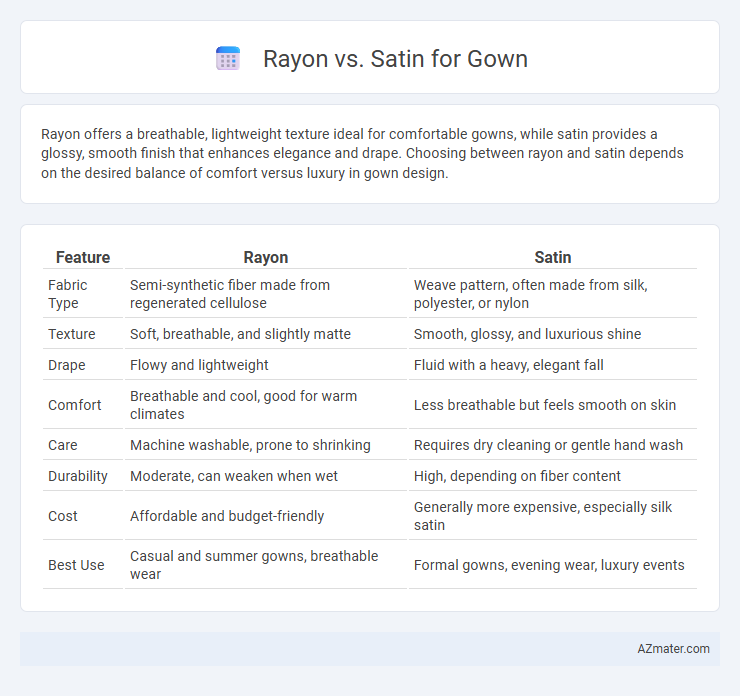Rayon offers a breathable, lightweight texture ideal for comfortable gowns, while satin provides a glossy, smooth finish that enhances elegance and drape. Choosing between rayon and satin depends on the desired balance of comfort versus luxury in gown design.
Table of Comparison
| Feature | Rayon | Satin |
|---|---|---|
| Fabric Type | Semi-synthetic fiber made from regenerated cellulose | Weave pattern, often made from silk, polyester, or nylon |
| Texture | Soft, breathable, and slightly matte | Smooth, glossy, and luxurious shine |
| Drape | Flowy and lightweight | Fluid with a heavy, elegant fall |
| Comfort | Breathable and cool, good for warm climates | Less breathable but feels smooth on skin |
| Care | Machine washable, prone to shrinking | Requires dry cleaning or gentle hand wash |
| Durability | Moderate, can weaken when wet | High, depending on fiber content |
| Cost | Affordable and budget-friendly | Generally more expensive, especially silk satin |
| Best Use | Casual and summer gowns, breathable wear | Formal gowns, evening wear, luxury events |
Introduction to Rayon and Satin
Rayon is a versatile semi-synthetic fiber known for its soft texture, breathability, and ability to mimic natural fibers like cotton, making it ideal for comfortable gowns. Satin refers to a weaving technique rather than a material, creating a glossy, smooth surface that enhances the elegance of gowns while commonly using fibers such as silk, polyester, or rayon. Both rayon and satin offer distinct benefits for gowns, with rayon providing lightweight comfort and satin delivering a luxurious sheen.
Key Differences Between Rayon and Satin
Rayon is a semi-synthetic fiber made from regenerated cellulose, offering breathability and a silky feel, while satin refers to a weaving technique that creates a glossy surface with a smooth texture. Rayon gowns tend to be lightweight, moisture-absorbent, and more affordable, whereas satin gowns exhibit a shiny finish, often made from silk, polyester, or nylon, providing a luxurious and elegant appearance. The primary difference lies in material origin and texture: rayon is a fabric fiber, while satin is defined by the weave and finish, influencing the gown's drape, sheen, and comfort.
Fabric Composition and Manufacturing Process
Rayon is a semi-synthetic fiber made from regenerated cellulose derived from wood pulp, produced through a chemical process that transforms natural polymers into versatile fabric. Satin refers to a weaving technique characterized by a glossy surface and smooth texture, which can be crafted from various fibers including silk, polyester, or rayon, offering a lustrous appearance ideal for gowns. The distinction lies in rayon's fiber origin and manufacturing involving cellulose regeneration, whereas satin emphasizes fabric surface structure achieved through specific weaving patterns.
Texture and Feel: Comparing Comfort
Rayon fabric offers a soft, breathable texture with a smooth feel that drapes elegantly, making it ideal for gowns requiring comfort in warm climates. Satin, known for its glossy sheen and silky surface, provides a luxurious, cool touch that feels smooth against the skin but may lack the breathability of rayon. Choosing between rayon and satin gowns depends on whether a lightweight, airy fabric or a lustrous, glamorous finish is preferred for comfort and style.
Durability and Longevity
Rayon gowns offer moderate durability as the fabric can weaken with prolonged moisture exposure, requiring careful maintenance to extend longevity. Satin, typically made from silk or polyester, boasts higher durability and a smooth finish that resists wrinkles and wear, making satin gowns ideal for long-term use. Choosing satin over rayon improves overall gown longevity due to its stronger fiber composition and enhanced resistance to environmental stress.
Breathability and Suitability for Various Climates
Rayon offers excellent breathability, making it ideal for warm and humid climates, as its moisture-absorbing properties help keep the wearer cool and comfortable. Satin, often made from synthetic fibers or silk, tends to have a less breathable, smoother surface that can trap heat, making it better suited for cooler climates or evening wear. Choosing between rayon and satin for a gown depends on the desired airflow and temperature regulation, with rayon excelling in ventilation and satin providing a luxurious feel in moderate to cool environments.
Appearance and Drape: Which Looks More Luxurious?
Satin gowns exhibit a glossy, smooth surface that reflects light, giving them a luxurious, high-shine appearance ideal for formal occasions. Rayon fabric offers a softer, matte finish with excellent drape, creating elegant fluidity but lacking satin's distinct lustrous sheen. In terms of luxurious look, satin's reflective qualities and structured drape typically convey a more opulent and glamorous aesthetic compared to rayon's subdued elegance.
Care and Maintenance Requirements
Rayon gowns require gentle hand washing or dry cleaning to prevent shrinking and weakening of fibers, as they are prone to water damage and stretching. Satin gowns, often made from silk or polyester blends, typically need dry cleaning to maintain their smooth, glossy finish and prevent snagging or discoloration. Proper storage in cool, dry places with padded hangers helps preserve the integrity and sheen of both rayon and satin gowns.
Cost Comparison: Rayon vs Satin Gowns
Rayon gowns typically offer a more budget-friendly option compared to satin gowns, making them accessible for everyday wear or casual events. Satin gowns, often crafted from silk or high-quality polyester blends, tend to have a higher price point due to their luxurious texture and sheen. Choosing between rayon and satin depends on balancing cost considerations with desired fabric appearance and event formality.
Which Fabric is Best for Your Gown?
Rayon offers a lightweight and breathable texture that drapes well, making it ideal for gowns requiring comfort and fluidity. Satin provides a glossy, luxurious finish with a smooth surface that enhances the elegance and formality of a gown. Choosing between rayon and satin depends on the desired balance between comfort and visual appeal for your specific gown occasion.

Infographic: Rayon vs Satin for Gown
 azmater.com
azmater.com